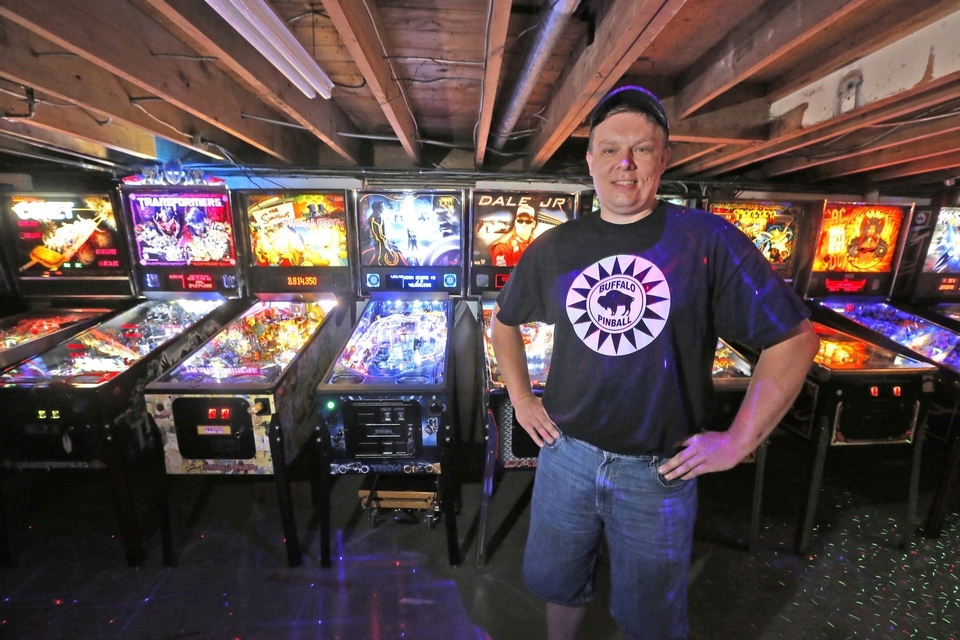
Classic pinball sees resurgence in popularity
Games provide socialization and a break from staring at a screen

These machines are just a fraction of the pinball collection housed in the Strykersville basement of collector John Barsh. Robert Kirkham/Buffalo News
Laser lights dance on the floor. A guitar solo rings from one arcade game as “pew, pew, pew!” dings from another. It’s like a rave in here.
Welcome to John Barsh’s basement.
Barsh, of Strykersville, has about 40 arcade games at his home, complete with the LED lights, subwoofers and other customizations he installed. Fifteen of them are pinball machines.
On one of his newest machines, a Metallica model, one button controls which song accompanies the game. “Enter Sandman” takes the gaming experience to another level.
Barsh spends hours, and tens of thousands of dollars, feeding his hobby. His basement is a symbol of the nationwide resurgence of pinball.
Not the video game version on a touch-screen tablet but the real deal, played on machines as big as a car hood that used to be at every pizzeria and dive bar in the neighborhood, with flashing lights, dinging bells and levers that jettison little balls.
Barsh is part of a new generation raised on Xboxes and smartphones who has rediscovered the delights of pinball.
“Everything is so digital these days,” said Kevin Manne, a member of the Buffalo Pinball League. “You sit at work and stare at a screen and come home and stare at a screen. This is a physical, real game.”
It’s gaining momentum in Buffalo, too. The Buffalo Pinball League formed last fall and the organizers, including Barsh and Manne, had to turn people away.
At Pinburgh, the annual Pittsburgh get-together for pinball enthusiasts across the nation, 400 people showed up this year to compete for more than $60,000. Seven hundred are expected next year, and the prize money could eclipse $100,000.
Stern Pinball Inc., the oldest remaining pinball machine producer, opened in the 1930s. It has seen a “great increase” in sales dating back to 2008, said Jody Dankberg, director of marketing and licensing. Stern, a private company, does not release financial numbers.
“Stern is healthy and thriving in 2014,” he said. “It is definitely a pinball renaissance. … Competitive pinball is more popular than ever.”
Pinball is generally a coin-operated game, though Barsh has set all his machines to free play. One player at a time accumulates points by pushing buttons on the sides of the machine to operate “flippers.”
Lifting a flipper at the right time keeps a steel ball from falling into a “drain” in between them. When the ball falls in the drain, the game is over, unless you have earned bonus turns (you’ll know because the machine will go berserk).
The game began as a derivative of billiards and bowling.
Legend has it that in the 1700s, a group of Frenchmen narrowed a billiards table and started playing what was essentially bowling with pool balls. But they were frustrated by how long it took to reset the pins, so they affixed them to the table – an early version of bumpers – and started shooting at holes in the table. Eventually the cue was replaced with a “plunger” – the type of launcher still in use on pinball machines today – and the term “Japanese billiards” was coined.
The game made several changes – for example, the balls were replaced with marbles – before arriving in the United States in the late 1800s.
In 1931, the first coin-operated game was introduced. With multiple turns available for one penny, the game spread rapidly as Americans sought inexpensive fun during the Depression.
Flippers were added in 1947; digital displays came along in the 1970s. New York City Mayor Fiorello La Guardia banned pinball in 1942, believing it was a form of gambling and taking money from kids.
He even raided establishments in the city and collected thousands of machines. In 1976, a man named Roger Sharpe was able to prove in court that pinball was a game of skill and not luck. The ban was lifted.
The emergence of video games in the 1980s severely lessened national interest in pinball. New manufacturers tried to revive the industry in the 1990s, but it only lasted a short while.
By 2000, excitement had died off again.
So, what’s the reason for the latest explosion of interest?
An Xbox game started it.
“The Pinball Arcade” first gained popularity on Xbox 360 and Xbox Live a couple of years ago. Now it’s available for PlayStation and as a smartphone app. Players can download “machines” that have the same appearance, point breakdowns and rules as actual machines.
Barsh’s fiancée has no problem with his collection, though it can get expensive. He said she knows it’s his “thing.” New machines cost up to $8,000.
To fund his fascination, Manne, who also hosted a night of competition, said he often buys and sells machines to keep his collection fresh.
“You buy what you’re able to without sacrificing your family or other things that are a priority to you,” Manne said.
Manne and Barsh are just two of the 23,000 players ranked nationally by the Professional & Amateur Pinball Association (PAPA). Players earn their spot at tournaments. Buffalo Pinball League President Nick Lane is currently around No. 480, he said, which is the highest known ranking in Western New York.
Like many, Lane got hooked on pinball by playing a video game version about 3ø years ago. “I realized there’s actually rules to it, actually depth and complexity,” he said. “It’s not just moving the ball around.”
Or, as group member Jay Fairbrother put it: “I never realized there were objectives until I started.”
Four to five years ago, PAPA started filming pinball games and posting the footage on its website with play-by-play and commentary. Lane said that also helped the game’s burgeoning popularity.
At the end of last year, there was just one pinball machine at Pocketeer Billiards on Clinton Street in Cheektowaga – a dusty Sopranos machine.
When owner Barry Gluckstein added a new Star Trek machine, though, Pinball League members started showing up.
“All of a sudden all these pinball guys kept coming by,” Gluckstein said.
He also owns a vending route, PG Vending, and had some other pinball machines at various bars.
“They never made any money anywhere,” Gluckstein said. “I said, ‘You know, I could bring them all here.’ More people kept coming in, so I said, ‘What the heck? I might as well try it.’”
His approach paid off. He now has 13 machines at Pocketeer. Two more – with 007 and Jurassic Park themes – will be out soon.
The Buffalo Pinball League ran its first eight-match season this year between September and April and playoffs in May.
There was an open tournament – the second of three this summer – Saturday at Pocketeer. Anyone could show up and join.
In the first tournament in June, Manne’s 7-year-old son, Logan, came in 16th out of 24 competitors. He often tags along with Dad, has been playing pinball for two years and has a national ranking.
It’s not that pinball is going to replace baseball for Logan, but he’ll likely be one of the youngsters carrying on the tradition of the hobby as he gets older.
Manne said the time a seasoned player could last on a machine depends on the specific game. On the older machines, a good player could last 10 minutes, whereas that player could last 45 minutes on newer, more forgiving machines.
The game might expand to a new platform. “People are saying it could wind up on TV,” Lane said.
No matter where the game goes from here, Barsh plans on continuing his basement collection, treating visitors to an awe-inspiring aesthetic experience. All in the name of pinball.
